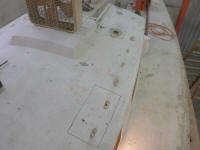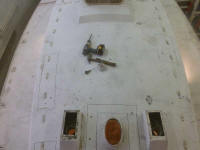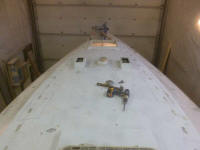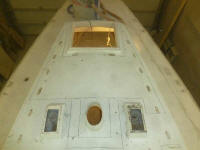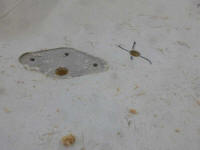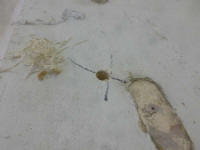
110 Cookson Lane | Whitefield, ME 04353 | 207-232-7600 | tim@lackeysailing.com
So far, Snow Lily had offered her fair share of surprises, but all along I'd known the decks required substantial attention, with a number of known soft spots indicative of wet and rotten core, and of course drab cosmetic condition. I didn't expect to be surprised by what I'd find when I started opening the decks for repair, and I wasn't.
I chose to begin on the coachroof and ultimately work my way downwards to the sidedecks and cockpit, though the operations would be necessarily separate since I needed the sidedecks intact in order to work on the coachroof. I inspected the area, using a hammer to sound for bad core and drilling sampling holes where needed. For a while, I'd suspected that some areas had been dealt with before, and my inspection bore this out: there was a large area over the center portion of the coachroof that contained plywood core material, rather than the balsa found elsewhere. More on this later.
Sounding and hole-sampling revealed a couple small-ish areas in the after half of the coachroof, but overall that was better than I'd anticipated. However, the entire forward end, up to and including around the mast partners, was extremely mushy underfoot. What was unclear was how far aft I'd have to open up in order to repair it all. As I went, I marked out the proposed cutlines on the deck. I thought it likely that these areas would expand, but hoped to avoid a wholesale recore of the entire coachroof.
Test holes drilled into the sections containing plywood revealed core that appeared damp or wet, but sounding results were generally OK in these areas. However, walking on the surface caused creaking and crackling sounds that suggested non-bonded core somewhere, so although I was hopeful, I'd have to wait and see what opening up the adjacent areas showed me about the plywood-cored sections.
I began with several of the smaller areas requiring repair, including the area around the hole from the old exhaust vent pipe, and two other areas (one on each side) a bit further forward. Each area, once opened, revealed core in various stages of decomposition, and I expanded the openings as needed to incorporate all the suspect areas, removing the core as I went.
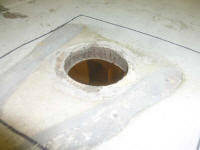
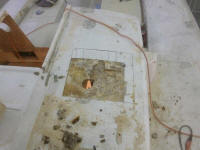
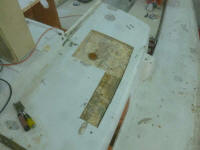
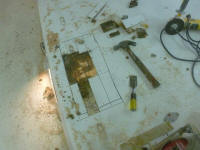
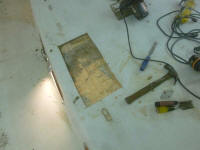
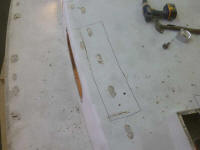
Next, I cut open the large foredeck section as far aft as the mast partners, and lifted off the whole section, as the core beneath was so badly deteriorated (except for one small, random island of dry, well-bonded core near the centerline). I cleaned out the old core, noting that there was plywood surrounding the forward hatch (and extending a couple inches outward), as well as around the mast step and other areas aft. This plywood was completely wet and delaminated.


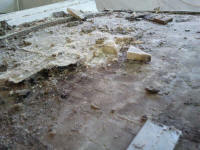

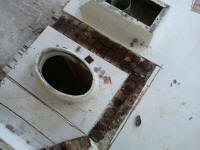
I'd hoped to find a way to avoid cutting out the molded Dorade boxes (which were part of the deck's molded top skin),but immediately it became clear that the core beneath these boxes (which extended all the way under the boxes and around the 3" vent hole through the decks) was completely trashed, and there was no option but to cut away the top deck surface in these areas as well. Not that the Dorades were anything special, but I hoped to avoid opening any areas I didn't need to. It appeared that a previous repair job had wrapped new plywood around these boxes, but never addressed the areas beneath, as there was old balsa in these areas; all the surrounding plywood was also wet.
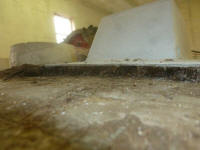
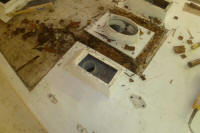
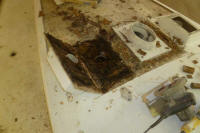
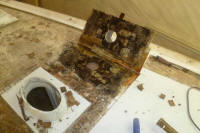
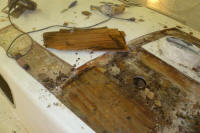
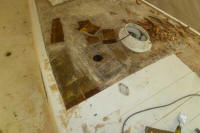
The aft extent of these cuts corresponded roughly with a line demarking the forward end of a large section recored previously with plywood. From here, as well as cuts extending into this section from the outboard sides of the coachroof, it was clear that the plywood was not only damp, but poorly (or not at all) adhered to the inner deck skin. It was this poor bonding that caused the creaking and crackling I'd noted earlier. The top deck skin was well bonded to the plywood, which is why sounding results had appeared positive, and the top layer of glass was quite thick and dense, if rather lumpy and bumpy (to the extent I could tell beneath the 27 layers of nonskid paint), and to my dismay it became clear that I'd have to remove all the plywood.
It was obvious why the plywood had failed so badly: someone, during installation, had sawn deep, wide kerfs into the material to allow it to bend into shape, and these kerfs acted perfectly as irrigation channels to ensure that any and all water that made its way into the decks from whatever source could extend to and damage all areas of the plywood. This was not a good idea.
With the day winding down, I made some saw cuts, ending the cut just aft of where the plywood recore job had ended, where there was sound, dry balsa. The edge of the plywood was clearly evident from an adjacent area I'd already opened, so I knew where to cut. Then, I removed the sections bit by bit across the coachroof; many sections came out almost intact, so poor or nonexistent was their bond to the lower skin, but in all cases the plywood was wet and delaminating from itself, even while remaining well bonded to the heavy top skin. I removed the core about 2/3 of the way across the width of the cabin trunk over this 2' wide area before I had to knock off for the day.
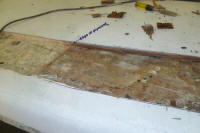

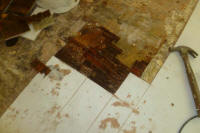
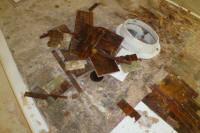
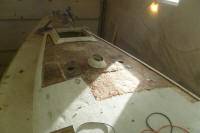

Total Time on This Job Today: 6.25 hours
